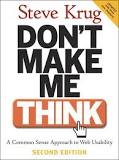About a year ago I finally started learning JavaScript so I could build complex, fast and fancy client web app that relies on restful services. I was completely new to this subject so I basically needed to learn everything from scratch… the language, best practices, architecture…
So here are resources I used for learning and libraries that helped me along the way.
JavaScript basics
First the language and most popular lib – jQuery.
Knockout
Knockout is great lib for MVVM that does client rendering and data binding.
Bootstrap
Grate CSS framework with fancy controls that supports responsive UI.
Controls
Additional controls that integrate nicely with Bootstrap.
Libs
In effort to teach myself more about web design I have read “Don’t make me think” by Steve Krug. I recommend the book to everyone interested in the same subject. This book seams as a good starting point and additionally it is small and is being read very fast. If you are planning to read this book maybe it is best to wait for the third edition that will be out soon. Update – third edition is out.

So here are my most important notes I am sharing so I can look them up later.
- Webpage should probably have following elements that should be easy to spot:
- Site ID/Logo and tagline – Indicates what site is this? It should be clickable and lead to home page.
- Site Sections – Indicates what are the major sections of this site? Current sections should be highlighted.
- Site Search – Especially important for users that prefer searching to browsing
- Utilities – Less important common link like login, home, how to by…
- Page name – Clearly informs user on what page are currently.
- Local (contextual) navigation - Show what are user options on current page?
- Breadcrumbs – Clearly explaining where user is in site hierarchy and offering easy way to go back to some upper level.
- Home page is different from the rest of the site and it should be designed more like billboard or cover of the magazine. For some visitors home page will be only chance to leave good impression about your site.
- Home page common elements:
- Site ID/Logo and tagline
- Site Sections – to give an overview of what site has to offer.
- Site Search
- Welcome blurb – short description of site that should be visible without scrolling.
- Teases – hints of good site good stuff (top stories, hot deals, most popular pages…)
- Timely content – like recent news/comments to signal that site is live and frequently updated.
- Start here – It should be clear to user how to begin using the site (e.g. user registration)
- Things that are related logically should be related visually
- Make it obvious what is clickable.
- Omit needles words. Design web pages for scanning, not reading.
- Good design makes web site obvious to users and it doesn’t requires them to think too much how to use it.
- Test usability of your site at least once a month.
Few weeks ago I was listening to a lecturer explaining how Salesforce works from programmer perspective. Among other things I have noted that SalesForce cares very much about their performance. They care so much that they have forbidden sequential access to the database. This is also why database access API are all designed to work with batches.
Few day ago I was writing MS SQL triggers for the first time after long time. Again I have noted that API for triggers is batched meaning that trigger is called only once after all rows in SQL statement are inserted/updated/deleted. Once trigger is called programmer can access virtual tables containing all altered rows. Off course alternative approach (not batched) would be to call trigger after each row update and this would lead to much poor performance.
Today I have analyzed some slow peace of code that is slow because it is sequentially loading many complex objects from database. At first there was a need to load only single complex object and that is what programmers implemented without support for batching (loading multiple objects at once). Once there was a need to load more objects programmers again did simplest thing - they just run single loader in a loop. Both choices sound logical to me but they lead to some slow peace of code that won’t be optimized without significant effort.
This lead me to thought that all APIs should be batched by default. This will lead to faster code and just slightly less convenient API in cases where we work with one object.
Update:
My friend Andrija Cacanović reminded me that JQuery’s fluent API is nice example of batched API.